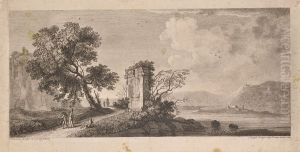Giuseppe Cunego Paintings
Giuseppe Cunego was an Italian engraver who was born in Verona in 1737. He is known for his remarkable skills in engraving, which is the art of incising a design onto a hard, usually flat surface, by cutting grooves into it. Cunego's work included a variety of subjects, including reproductions of paintings, portraits, and historical scenes. His contributions to the field of printmaking were significant during the 18th century, a period that saw a flourishing of the arts in Europe, particularly in Italy.
Cunego began his artistic career as a painter, studying under his brother who was also an artist. However, he soon discovered that his true talent lay in the field of engraving. He moved to Rome to further his career, where he studied under the celebrated engraver Carlo Antonini. Under Antonini's guidance, Cunego honed his skills and developed a keen eye for detail, which would become a hallmark of his work.
His engravings were highly sought after and he became particularly known for his work reproducing the paintings of the famous painter Raphael. Among his most notable works are the engravings of 'The Transfiguration of Christ' and 'The Madonna of Foligno', both based on Raphael's originals. Cunego's engravings were characterized by their precision and clarity, which allowed the subtleties of the original paintings to be appreciated in a different medium.
Throughout his career, Cunego received commissions from many important patrons, and his engravings were collected by art connoisseurs across Europe. His works were not only appreciated for their aesthetic beauty but also for their ability to disseminate the works of great painters to a wider audience, which was particularly important during a time when travel was limited and access to original artworks was restricted to the elite.
Giuseppe Cunego's legacy is found in the many prints that circulated during his lifetime, influencing other engravers and contributing to the spread of artistic ideas. He passed away in 1812, leaving behind a body of work that continues to be studied and appreciated by art historians, collectors, and print enthusiasts. Cunego's engravings remain a testament to his skill and to the rich tradition of Italian printmaking during the 18th century.
